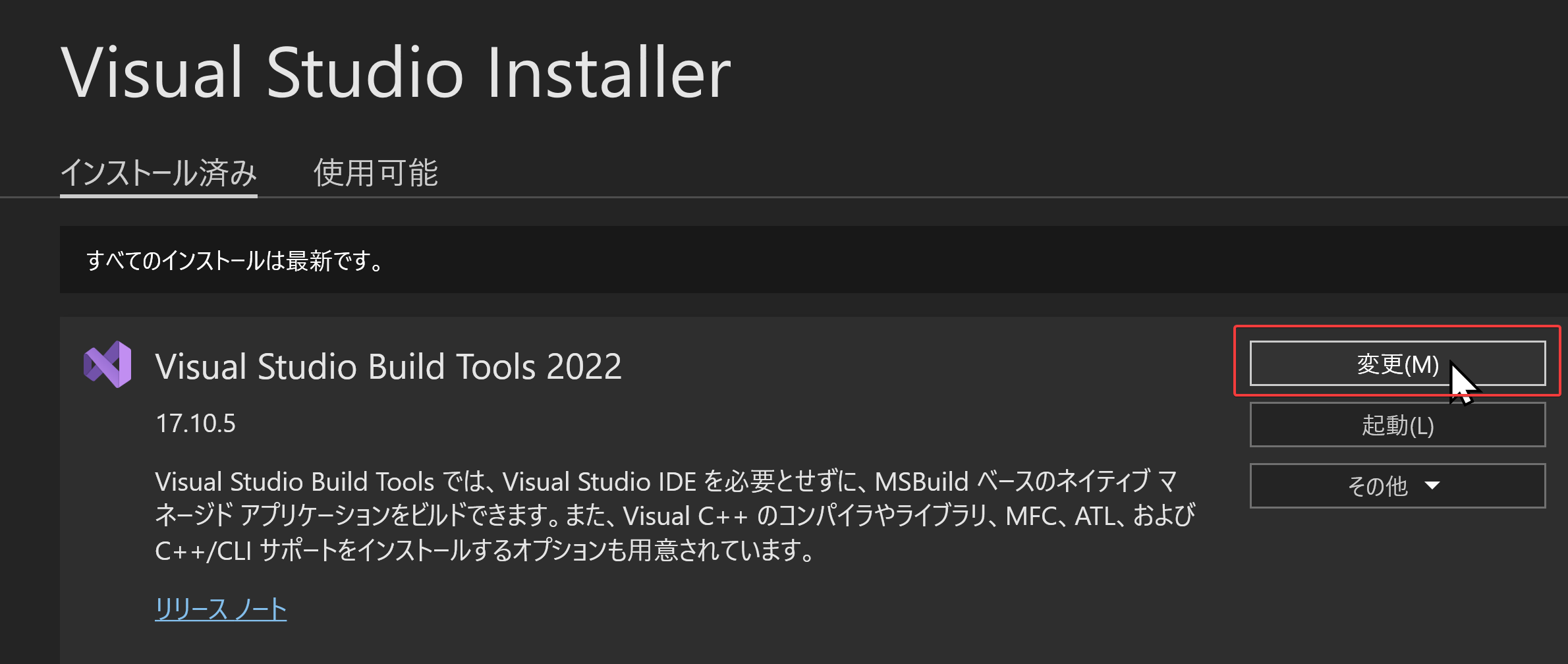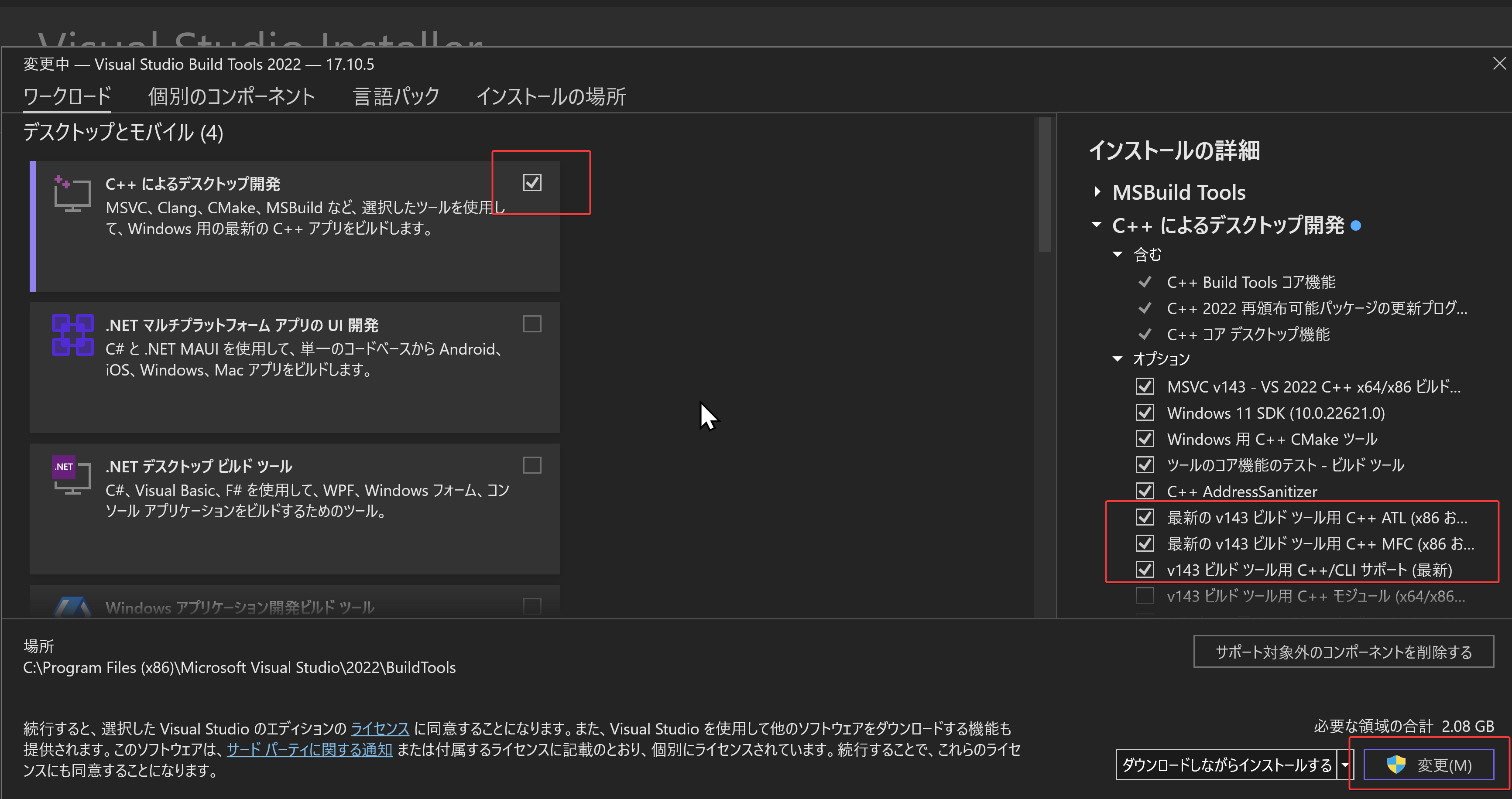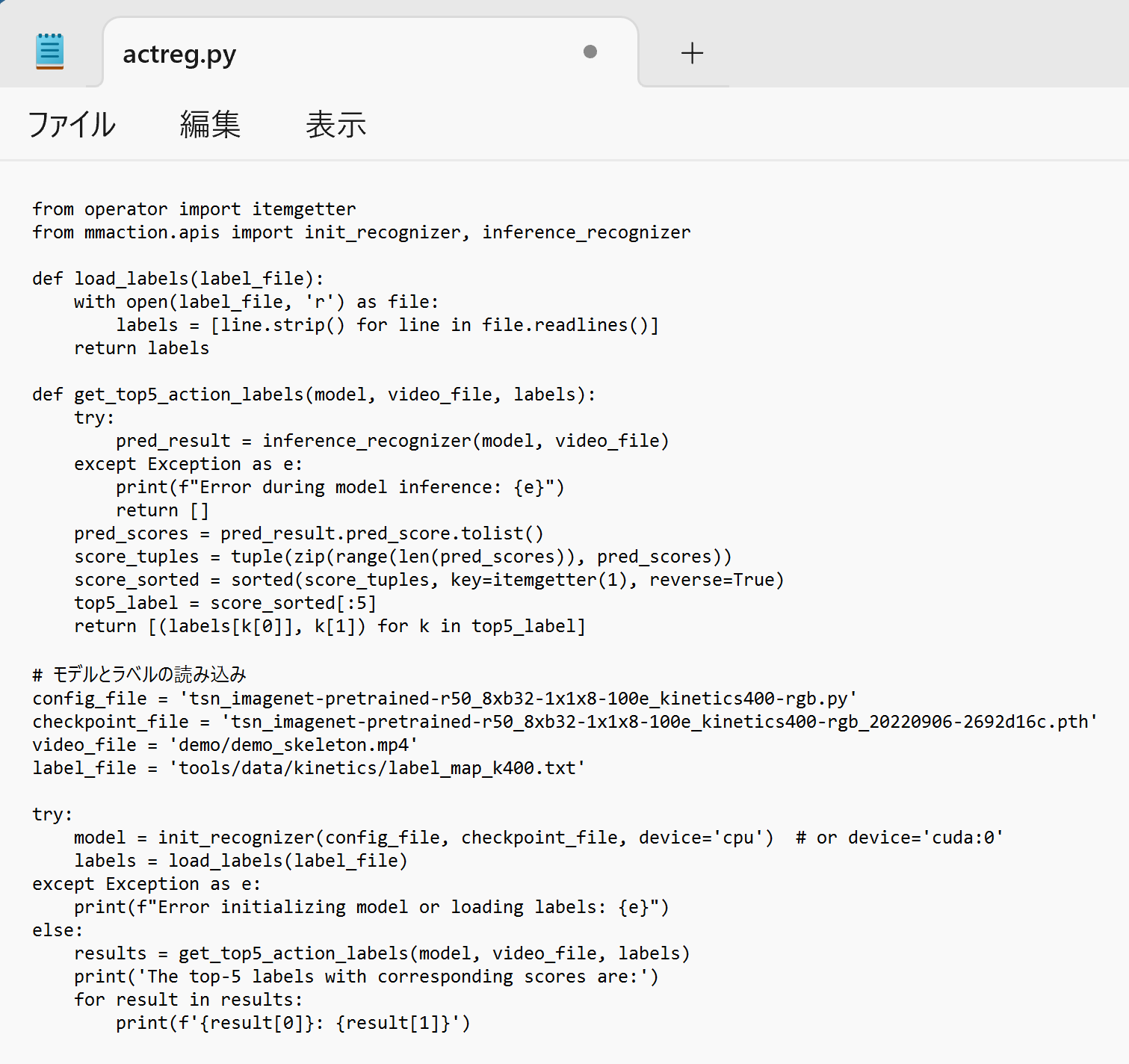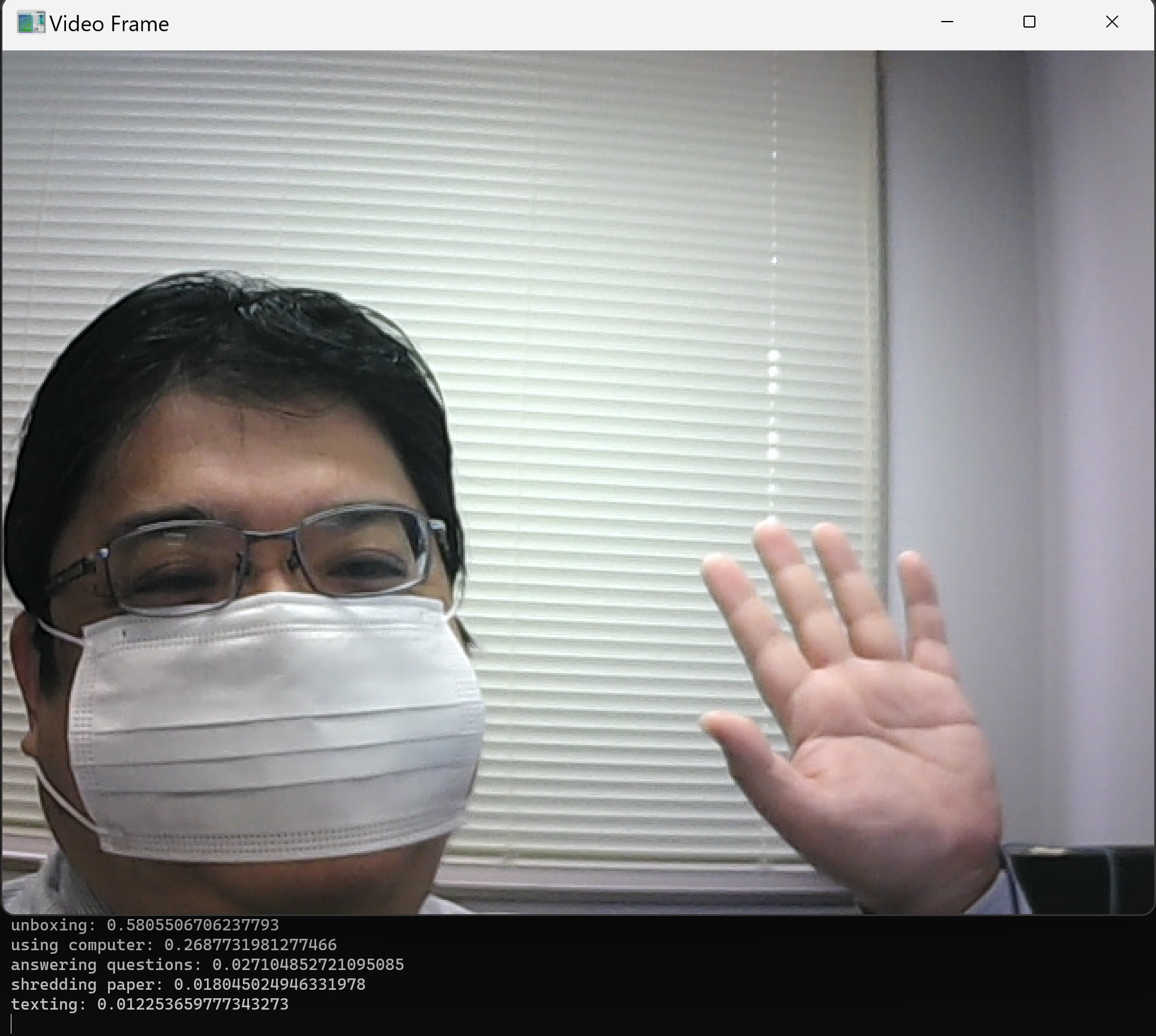動作認識,動作認識を行う Python プログラム(MMAction,Python,PyTorch を使用)(Windows 上)
【目次】
前準備
Build Tools for Visual Studio 2022 (ビルドツール for Visual Studio 2022)または Visual Studio 2022 のインストール(Windows 上)
【インストールの判断】 Build Tools for Visual Studio は,開発ツールセットである. Visual Studio は統合開発環境であり,いくつかの種類があり,Build Tools for Visual Studioの機能を含むか連携して使用するものである.インストールは以下の基準で判断してください:
- Build Tools for Visual Studio の機能のみが必要な場合
- Visual Studio の機能が必要である,あるいは,よく分からない場合
Visual Studio 2022 をインストールする際に,「C++ によるデスクトップ開発」を選択することで, Build Tools for Visual Studio 2022 の機能も一緒にインストールされる.
不明な点がある場合は,Visual Studio 全体をインストール を行う方が良い.
Build Tools for Visual Studio 2022 のインストール(Windows 上)
- Windows で,管理者権限でコマンドプロンプトを起動(手順:Windowsキーまたはスタートメニュー >
cmdと入力 > 右クリック > 「管理者として実行」)。次のコマンドを実行
次のコマンドは,Build Tools for Visual Studio 2022と VC2015 再配布可能パッケージをインストールするものである.
winget install --scope machine Microsoft.VisualStudio.2022.BuildTools winget install --scope machine Microsoft.VCRedist.2015+.x64
- Build Tools for Visual Studio 2022 での C++ によるデスクトップ開発,CLI,ATL,MFC のインストール(Windows 上)
- Visual Studio Installer の起動
起動方法: スタートメニューの「Visual Studio Installer」を選ぶ.
- Visual Studio Build Tools 2022 で「変更」を選ぶ.

- 「C++ によるデスクトップ開発」をクリック.そして,画面右側の「インストール」の詳細で「v143 ビルドツール用 C++/CLI サポート(最新)」,「ATL」,「MFC」をチェックする.その後,「変更」をクリック.

- Visual Studio Installer の起動
Visual Studio のインストール(Windows 上)
- Windows で,管理者権限でコマンドプロンプトを起動(手順:Windowsキーまたはスタートメニュー >
cmdと入力 > 右クリック > 「管理者として実行」)。次のコマンドを実行
- 管理者権限でコマンドプロンプトを起動(手順:Windowsキーまたはスタートメニュー >
cmdと入力 > 右クリック > 「管理者として実行」)。 - インストールコマンドの実行
winget install Microsoft.VisualStudio.2022.Community --scope machine --override "--add Microsoft.VisualStudio.Workload.NativeDesktop Microsoft.VisualStudio.ComponentGroup.NativeDesktop.Core Microsoft.VisualStudio.Component.VC.CLI.Support Microsoft.VisualStudio.Component.CoreEditor Microsoft.VisualStudio.Component.NuGet Microsoft.VisualStudio.Component.Roslyn.Compiler Microsoft.VisualStudio.Component.TextTemplating Microsoft.VisualStudio.Component.Windows.SDK.Latest Microsoft.VisualStudio.Component.VC.Tools.x86.x64 Microsoft.VisualStudio.Component.VC.ATL Microsoft.VisualStudio.Component.VC.ATLMFC" winget install Microsoft.VisualStudio.2022.Community --scope machine Microsoft.VCRedist.2015+.x64
インストールされるコンポーネントの説明:
NativeDesktop:C++によるデスクトップアプリケーション開発のためのワークロード一式NativeDesktop.Core:C++デスクトップ開発に必要な基本コンポーネント群VC.CLI.Support:マネージドコードとネイティブコードの統合開発を可能にするC++/CLIサポートCoreEditor:コード編集,デバッグ,検索などの基本機能を提供するVisual StudioのコアエディタNuGet:.NETライブラリの依存関係を管理するパッケージ管理システムWindows.SDK.Latest:Windows 向けアプリケーション開発用SDK(Software Development Kit)VC.Tools.x86.x64:32ビット及び64ビット向けC++コンパイラとビルドツールVC.ATL:Windowsコンポーネント開発用のActive Template LibraryVC.ATLMFC:デスクトップアプリケーション開発用のMicrosoft Foundation Class Library
システム要件と注意事項:
- 管理者権限でのインストールが必須
- 必要ディスク容量:10GB以上
- 推奨メモリ:8GB以上のRAM
- インストール過程でシステムの再起動が要求される可能性がある
- 安定したインターネット接続環境が必要
追加のコンポーネントが必要な場合は,Visual Studio Installerを使用して個別にインストールすることが可能である.
- インストール完了の確認
winget list Microsoft.VisualStudio.2022.Community
トラブルシューティング:
インストール失敗時は,以下のログファイルを確認:
%TEMP%\dd_setup_<timestamp>.log %TEMP%\dd_bootstrapper_<timestamp>.log
- 管理者権限でコマンドプロンプトを起動(手順:Windowsキーまたはスタートメニュー >
- Visual Studio での C++ によるデスクトップ開発,CLI のインストール(Windows 上)
- Visual Studio Installer の起動
起動方法: スタートメニューの「Visual Studio Installer」を選ぶ.
- Visual Studio Community 2022 で「変更」を選ぶ.
- 「C++ によるデスクトップ開発」をチェック.そして,画面右側の「インストール」の詳細で「v143 ビルドツール用 C++/CLI サポート(最新)」をチェックする.その後,「インストール」をクリック.
- Visual Studio Installer の起動
Python 3.12,Git のインストール(Windows 上)
Pythonは,プログラミング言語の1つ. Gitは,分散型のバージョン管理システム.
【手順】
- Windows で,管理者権限でコマンドプロンプトを起動(手順:Windowsキーまたはスタートメニュー >
cmdと入力 > 右クリック > 「管理者として実行」)。次のコマンドを実行
次のコマンドは,Python ランチャーとPython 3.12とGitをインストールし,Gitにパスを通すものである.
次のコマンドでインストールされるGitは 「git for Windows」と呼ばれるものであり, Git,MinGW などから構成されている.
reg add "HKLM\SYSTEM\CurrentControlSet\Control\FileSystem" /v LongPathsEnabled /t REG_DWORD /d 1 /f REM Python, Git をシステム領域にインストール winget install --scope machine --id Python.Python.3.12 --id Python.Launcher --id Git.Git -e --silent REM Python のパス set "INSTALL_PATH=C:\Program Files\Python312" echo "%PATH%" | find /i "%INSTALL_PATH%" >nul if errorlevel 1 setx PATH "%PATH%;%INSTALL_PATH%" /M >nul echo "%PATH%" | find /i "%INSTALL_PATH%\Scripts" >nul if errorlevel 1 setx PATH "%PATH%;%INSTALL_PATH%\Scripts" /M >nul REM Git のパス set "NEW_PATH=C:\Program Files\Git\cmd" if exist "%NEW_PATH%" echo "%PATH%" | find /i "%NEW_PATH%" >nul if exist "%NEW_PATH%" if errorlevel 1 setx PATH "%PATH%;%NEW_PATH%" /M >nul
【関連する外部ページ】
- Python の公式ページ: https://www.python.org/
- Git の公式ページ: https://git-scm.com/
【サイト内の関連ページ】
【関連項目】 Python, Git バージョン管理システム, Git の利用
Build Tools for Visual Studio 2022,NVIDIA ドライバ,NVIDIA CUDA ツールキット 11.8,NVIDIA cuDNN 8.9.7 のインストール(Windows 上)
【サイト内の関連ページ】 NVIDIA グラフィックスボードを搭載しているパソコンの場合には, NVIDIA ドライバ, NVIDIA CUDA ツールキット, NVIDIA cuDNN のインストールを行う.
- Windows での Build Tools for Visual Studio 2022 のインストール: 別ページ »で説明
- Windows での NVIDIA ドライバ,NVIDIA CUDA ツールキット 11.8,NVIDIA cuDNN v8.9.7 のインストール手順: 別ページ »で説明
【関連する外部ページ】
- Build Tools for Visual Studio 2022 (ビルドツール for Visual Studio 2022)の公式ダウンロードページ: https://visualstudio.microsoft.com/ja/visual-cpp-build-tools/
- NVIDIA ドライバのダウンロードの公式ページ: https://www.nvidia.co.jp/Download/index.aspx?lang=jp
- NVIDIA CUDA ツールキットのアーカイブの公式ページ: https://developer.nvidia.com/cuda-toolkit-archive
- NVIDIA cuDNN のダウンロードの公式ページ: https://developer.nvidia.com/cudnn
PyTorch のインストール(Windows 上)
- Windows で,管理者権限でコマンドプロンプトを起動(手順:Windowsキーまたはスタートメニュー >
cmdと入力 > 右クリック > 「管理者として実行」)。 - PyTorch のページを確認
- 次のようなコマンドを実行(実行するコマンドは,PyTorch のページの表示されるコマンドを使う).
次のコマンドを実行することにより, PyTorch 2.3 (NVIDIA CUDA 11.8 用)がインストールされる. 但し,Anaconda3を使いたい場合には別手順になる.
事前に NVIDIA CUDA のバージョンを確認しておくこと(ここでは,NVIDIA CUDA ツールキット 11.8 が前もってインストール済みであるとする).
PyTorch で,GPU が動作している場合には,「torch.cuda.is_available()」により,True が表示される.
python -m pip install -U --ignore-installed pip python -m pip uninstall -y torch torchvision torchaudio torchtext xformers python -m pip install -U torch torchvision torchaudio numpy --index-url https://download.pytorch.org/whl/cu118 python -c "import torch; print(torch.__version__, torch.cuda.is_available())"

Anaconda3を使いたい場合には, Anaconda プロンプト (Anaconda Prompt) を管理者として実行し, 次のコマンドを実行する. (PyTorch と NVIDIA CUDA との連携がうまくいかない可能性があるため,Anaconda3を使わないことも検討して欲しい).
conda install -y pytorch torchvision torchaudio pytorch-cuda=11.8 cudnn -c pytorch -c nvidia py -c "import torch; print(torch.__version__, torch.cuda.is_available())"
【サイト内の関連ページ】
【関連する外部ページ】
MMAction のインストール(Windows 上)
- Windows で,管理者権限でコマンドプロンプトを起動(手順:Windowsキーまたはスタートメニュー >
cmdと入力 > 右クリック > 「管理者として実行」)。 - ダウンロードとインストール
python -m pip install -U openmim mim install mmengine mim install mmcv mim install mmdet mim install mmpose cd /d c:%HOMEPATH% rmdir /s /q mmaction2 git clone https://github.com/open-mmlab/mmaction2.git cd mmaction2 pip install -v -e . mim download mmaction2 --config tsn_imagenet-pretrained-r50_8xb32-1x1x8-100e_kinetics400-rgb --dest .
- 終了の確認
エラーメッセージが出ていないこと.

MMAction の動作確認(Windows 上)
- Windows で,コマンドプロンプトを実行
- エディタを起動
cd /d c:%HOMEPATH%\mmaction2 notepad actreg.py

- エディタで,次のプログラムを保存
このプログラムは, 公式の GitHub のページで公開されていたものを変更して使用している.
このプログラムは,動作認識のためにMMActionを使用する.事前学習済みモデルを読み込んで指定されたビデオファイルで実行し,動作認識結果の上位5位の動作ラベルとそれに対応するスコアを表示する.
- ラベルファイルの読み込み:load_labels関数は,指定されたラベルファイルを読み込み,各行の末尾の空白を取り除いたリストを返す.
- モデルの初期化:init_recognizer関数は,指定された設定ファイルとチェックポイントファイルを使用して,動作認識のモデルを初期化する.
- 動作認識の実行:get_top5_action_labels関数は,モデルとビデオファイルを引数として受け取り,モデルを使用してビデオから動作を認識する.その後,スコアに基づいて上位5位の動作ラベルを選択し,これらのラベルとスコアのリストを返す.
- エラーハンドリング:モデルの初期化とラベルの読み込みに失敗した場合,または動作認識中に例外が発生した場合にエラーメッセージを表示する.
- 結果の表示:動作認識結果の上位5位の動作ラベルとそれに対応するスコアを表示する.
from operator import itemgetter from mmaction.apis import init_recognizer, inference_recognizer def load_labels(label_file): with open(label_file, 'r') as file: labels = [line.strip() for line in file.readlines()] return labels def get_top5_action_labels(model, video_file, labels): try: pred_result = inference_recognizer(model, video_file) except Exception as e: print(f"Error during model inference: {e}") return [] pred_scores = pred_result.pred_score.tolist() score_tuples = tuple(zip(range(len(pred_scores)), pred_scores)) score_sorted = sorted(score_tuples, key=itemgetter(1), reverse=True) top5_label = score_sorted[:5] return [(labels[k[0]], k[1]) for k in top5_label] # モデルとラベルの読み込み config_file = 'tsn_imagenet-pretrained-r50_8xb32-1x1x8-100e_kinetics400-rgb.py' checkpoint_file = 'tsn_imagenet-pretrained-r50_8xb32-1x1x8-100e_kinetics400-rgb_20220906-2692d16c.pth' video_file = 'demo/demo_skeleton.mp4' label_file = 'tools/data/kinetics/label_map_k400.txt' try: model = init_recognizer(config_file, checkpoint_file, device='cpu') # or device='cuda:0' labels = load_labels(label_file) except Exception as e: print(f"Error initializing model or loading labels: {e}") else: results = get_top5_action_labels(model, video_file, labels) print('The top-5 labels with corresponding scores are:') for result in results: print(f'{result[0]}: {result[1]}')
- Python プログラムの実行
Python プログラムの実行
- Windows では python (Python ランチャーは py)
- Ubuntu では python3
Python 開発環境(Jupyter Qt Console, Jupyter ノートブック (Jupyter Notebook), Jupyter Lab, Nteract, Spyder, PyCharm, PyScripterなど)も便利である.
Python のまとめ: 別ページ »にまとめ
プログラムを actreg.pyのようなファイル名で保存したので, 「python actreg.py」のようなコマンドで行う.
cd /d c:%HOMEPATH%\mmaction2 python actreg.py

- 結果の確認

他の動画を試したいときは, cd /d c:%HOMEPATH%\mmaction2\demo に動画ファイルを置き, actreg.py の「video_file = 'demo/demo_skeleton.mp4'」のところを変更して実行する.
MMAction を使う Python プログラムの実行(Windows 上)
ビデオカメラの動作認識を行うプログラム
- Windows で,コマンドプロンプトを実行
- エディタを起動
cd /d c:%HOMEPATH%\mmaction2 notepad vidactreg.py
- エディタで,次のプログラムを保存
ビデオカメラから読み込み,一定数(ここでは30)のフレームが集まるたびに,最新の120フレームを使用して動作認識を実行する.これを行うために,フレームを一時的に保存するバッファ(リスト)を使用する.このプログラムでは,ビデオからフレームを読み込み,frame_buffer(Pythonのdequeを使用)に保存する.このバッファは最大120フレームを保持し,古いフレームは自動的に削除される.30フレームごとにrecognize_action関数を呼び出し,その時点での最新の120フレームで動作認識を実行する.
import cv2 from mmaction.apis import init_recognizer, inference_recognizer from collections import deque from operator import itemgetter # モデルとラベルの初期化 def initialize_model(config_file, checkpoint_file): try: model = init_recognizer(config_file, checkpoint_file, device='cpu') # or 'cuda:0' return model except Exception as e: print(f"Error initializing model: {e}") return None # ラベルの読み込み def load_labels(label_file): with open(label_file, 'r') as file: labels = [line.strip() for line in file.readlines()] return labels # アクション認識と結果の表示 def recognize_action(model, frames, labels): try: pred_result = inference_recognizer(model, frames) pred_scores = pred_result.pred_score.tolist() score_tuples = tuple(zip(range(len(pred_scores)), pred_scores)) score_sorted = sorted(score_tuples, key=itemgetter(1), reverse=True) top5_label = score_sorted[:5] results = [(labels[k[0]], k[1]) for k in top5_label] for result in results: print(f'{result[0]}: {result[1]}') except Exception as e: print(f"Error during model inference: {e}") def process_video(config_file, checkpoint_file, label_file): model = initialize_model(config_file, checkpoint_file) labels = load_labels(label_file) if not model: return cap = cv2.VideoCapture(0) frame_buffer = deque(maxlen=120) # フレームサイズを取得(動画ファイルの初期化用) frame_width = int(cap.get(cv2.CAP_PROP_FRAME_WIDTH)) frame_height = int(cap.get(cv2.CAP_PROP_FRAME_HEIGHT)) while True: ret, frame = cap.read() if not ret: break frame_buffer.append(frame) vidfile = 'a.mp4' if len(frame_buffer) % 30 == 0: # 30フレームごとに # ビデオファイルへの書き込みの初期化 out = cv2.VideoWriter(vidfile, cv2.VideoWriter_fourcc(*'mp4v'), 30, (frame_width, frame_height)) # バッファ内のフレームをビデオファイルに書き込み for f in frame_buffer: out.write(f) out.release() # ビデオライターを解放 recognize_action(model, vidfile, labels) cv2.imshow('Video Frame', frame) if cv2.waitKey(1) & 0xFF == ord('q'): break cap.release() cv2.destroyAllWindows() # モデルとラベルの読み込み config_file = 'tsn_imagenet-pretrained-r50_8xb32-1x1x8-100e_kinetics400-rgb.py' checkpoint_file = 'tsn_imagenet-pretrained-r50_8xb32-1x1x8-100e_kinetics400-rgb_20220906-2692d16c.pth' label_file = 'tools/data/kinetics/label_map_k400.txt' # ビデオ処理の実行 process_video(config_file, checkpoint_file, label_file) - Python プログラムの実行
Python プログラムの実行
- Windows では python (Python ランチャーは py)
- Ubuntu では python3
Python 開発環境(Jupyter Qt Console, Jupyter ノートブック (Jupyter Notebook), Jupyter Lab, Nteract, Spyder, PyCharm, PyScripterなど)も便利である.
Python のまとめ: 別ページ »にまとめ
プログラムを vidactreg.pyのようなファイル名で保存したので, 「python vidactreg.py」のようなコマンドで行う.
cd /d c:%HOMEPATH%\mmaction2 python vidactreg.py
- 結果の確認

- Windows で,管理者権限でコマンドプロンプトを起動(手順:Windowsキーまたはスタートメニュー >
![[kaneko lab.]](https://www.kkaneko.jp/info/logo_png.png)